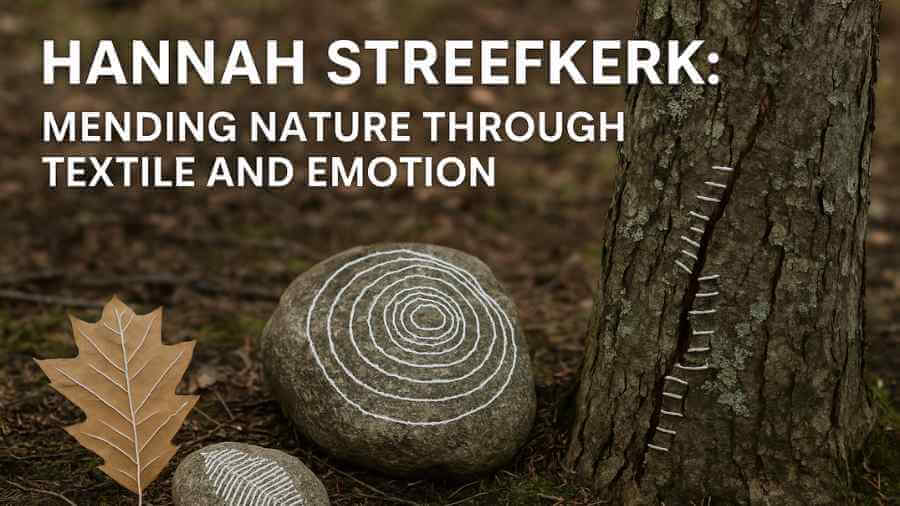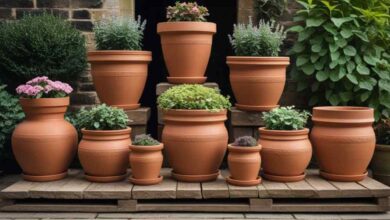Hannah Streefkerk: The Art of Mending Nature Through Textile and Emotion

In the contemporary world of art, few creators have left as gentle yet profound an imprint on the landscape of textile and environmental art as Hannah Streefkerk. Born in the Netherlands in 1973, Streefkerk’s artistic vision revolved around the idea of “mending nature” — a poetic metaphor that she brought to life through threads, fabric, and intricate handwork. Her art was not about grand gestures or monumental sculptures, but about intimacy, attention, and the deep emotional act of repair. Using traditional textile techniques such as embroidery, crochet, and stitching, she transformed the way we look at both art and nature, urging viewers to care, observe, and reconnect with the fragile world around them.
Although her life was tragically cut short in 2022, her works continue to inspire artists, environmentalists, and admirers worldwide. Hannah Streefkerk’s art stands as a lasting reminder that creativity can heal — not only nature but also our perception of it.
Early Life and Artistic Roots
Hannah Streefkerk was born and raised in the Netherlands, where she developed a love for natural surroundings from a young age. The Dutch landscape, with its quiet meadows, trees, rivers, and shifting skies, profoundly influenced her artistic sensibility. She went on to study art at the academies of Maastricht and Groningen, where she gained her Master’s degree in visual arts.
During her early training, Streefkerk was drawn to materials that felt alive — textiles, fibres, and natural elements such as stones and leaves. Rather than pursuing purely abstract or digital mediums, she grounded her work in tactile reality. The slow, meditative act of stitching became central to her creative identity. Over time, this technique evolved into a symbolic language — one that expressed care, vulnerability, and repair.
The Concept of “Mending Nature”
The phrase “mending nature” encapsulates the soul of Hannah Streefkerk’s art. It reflects her belief that art can serve as a bridge between human beings and the natural environment. Her projects often depicted the human desire to fix, heal, or preserve aspects of nature that are damaged or overlooked.
For instance, she would stitch around cracks in rocks, sew leaves together, or wrap stones with thread as if bandaging a wound. Through these acts, she did not claim to literally repair nature but to symbolically draw attention to its fragility. Each stitch was a gesture of respect — an acknowledgment of our dependence on the earth and the responsibility we share in protecting it.
Streefkerk’s approach combined ecology, craftsmanship, and emotion. Unlike industrial art or mass-produced installations, her work celebrated slowness. Every piece was handmade, often outdoors, with immense patience. This intimate process gave her creations a sense of authenticity that resonated deeply with audiences around the world.
Techniques and Materials
Hannah Streefkerk’s artistic techniques were grounded in traditional textile methods but reimagined for natural settings. She used materials like cotton thread, linen, and wool, alongside natural elements such as bark, sand, leaves, and stones. Her most distinctive method involved embroidery and crochet performed directly onto objects found in the landscape.
By doing this, she blurred the boundary between human craft and natural form. Her stitches followed the curves of leaves, the cracks of stones, or the grain of wood, making it seem as though nature itself was participating in the artwork. The resulting pieces were both delicate and durable, reflecting the tension between vulnerability and strength that defines the natural world.
Her art also explored colour subtly. She preferred soft, earthy tones — greens, browns, whites, and muted blues — evoking the hues of moss, soil, and sky. These choices reinforced her connection to organic environments and her rejection of artificial excess.
Connection Between Nature and Humanity
Hannah Streefkerk’s work was not only about nature as a physical entity but also as a metaphor for human experience. Just as she repaired leaves or bound together stones, her art invited reflection on emotional healing and personal resilience. The act of mending in her work could be read as an act of empathy — towards both the earth and the self.
She often stated in interviews that her intention was to make people aware of their surroundings, to notice the beauty in small imperfections. In modern life, where everything is disposable, her art taught patience, observation, and care. Each stitch symbolised a heartbeat, a pause, a moment of attention. Through this mindfulness, she reconnected the viewer with a sense of belonging to the planet.
Major Works and Installations
Throughout her career, Hannah Streefkerk exhibited her art internationally, from Europe to Australia. One of her most famous installations, “To Take Care Of”, was displayed at Sculpture by the Sea in Bondi, Australia, in 2014. This piece featured stones wrapped carefully with white bandages, as if nature had suffered wounds that required tending. It became a powerful visual statement on environmental care and human compassion.
Another remarkable project, “To Remember”, was shown in Kassel, Germany, during the “Bewegter Wind” exhibition, where it won first prize. This installation reflected on memory and the traces humans leave in nature, combining visual beauty with deep emotional resonance.
Other notable works such as “Crack Lines,” “Restorations,” and “Mended Leaves” expanded on these themes. Each piece was site-specific, meaning it was created for and integrated into a particular natural location. This approach ensured that her art never dominated the environment but harmonised with it — a dialogue rather than a statement.
The Philosophy Behind Her Art
Hannah Streefkerk’s artistic philosophy stemmed from her respect for imperfection. She was inspired by natural patterns — the veins of a leaf, the ripples of water, the textures of bark — and viewed them as metaphors for life’s complexity. She believed that the beauty of nature lies in its irregularities and that the act of mending was not about making something “perfect” again but about honouring its journey.
Her work reflected a quiet form of activism. Without slogans or protests, she raised awareness about the impact of environmental degradation. She gently reminded audiences that our relationship with the earth should be one of care rather than control. In this sense, her art stood against the fast-paced, consumption-driven modern world. It encouraged sustainability, mindfulness, and gratitude.
Life in Sweden and Later Years
Later in life, Hannah Streefkerk moved to Sweden, where the vast forests, lakes, and seasons further influenced her creative expression. Living close to nature gave her the solitude and inspiration she cherished. She continued to produce thought-provoking installations and participated in numerous international exhibitions and art collectives, including the “62 Group,” which focused on advancing textile art.
Tragically, in December 2022, she passed away in a car accident, leaving behind an extraordinary legacy. Her untimely death was a great loss to the art world, but her influence continues to grow as more people discover her works and philosophy.
Legacy and Influence
Hannah Streefkerk’s art remains an enduring symbol of care and restoration. She showed that art does not need to be loud to make a difference. Instead of depicting environmental destruction, she offered a vision of repair and hope. Her legacy continues to inspire contemporary textile artists and environmental thinkers who see the world through a lens of compassion and balance.
Her approach also resonates strongly in the context of today’s sustainability movements. As more people seek to reconnect with nature and adopt slower, more mindful lifestyles, Streefkerk’s art feels more relevant than ever. Schools, museums, and galleries continue to display her works, introducing new generations to her philosophy of respect and renewal.
Personal Interpretation of Her Work
Looking at Hannah Streefkerk’s art is like reading a poem written in thread and leaf. Every line of stitching feels like a whisper, every repaired object like a message of hope. She reminded us that even though we cannot fully heal nature’s wounds, we can acknowledge them — and that act of acknowledgment is itself healing.
Her art teaches us that to care is to notice. To mend is to love. And through her gentle interventions in the landscape, she redefined what it means to be an artist in the modern world — someone who not only creates beauty but restores meaning to it.
Conclusion
Hannah Streefkerk’s journey as an artist reveals the power of tenderness in a world often dominated by speed and neglect. Her philosophy of “mending nature” represents more than a creative approach — it is a call to action, urging humanity to reconnect with the planet and rediscover the joy of small, deliberate acts of care.
Through her delicate use of textiles, she built bridges between art and ecology, between human emotion and natural form. Even after her passing, her legacy continues to bloom in the hearts of those who value simplicity, empathy, and sustainability.



